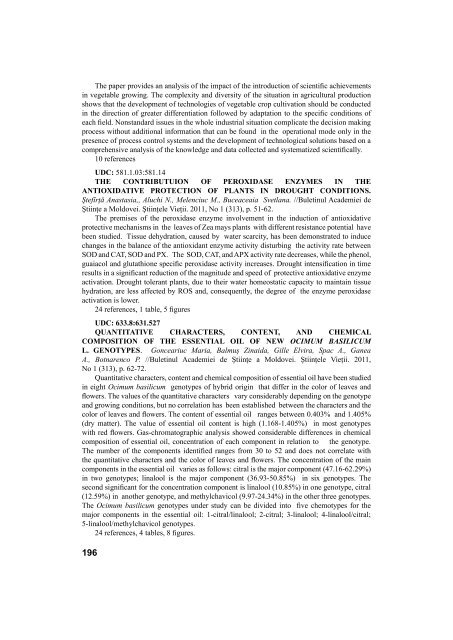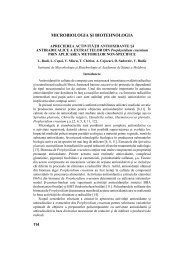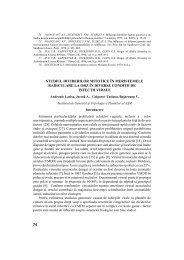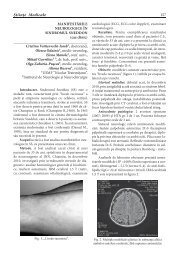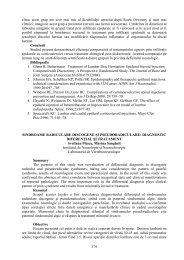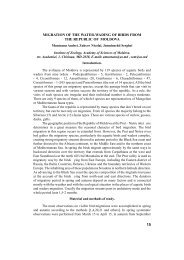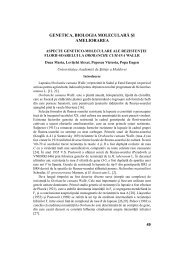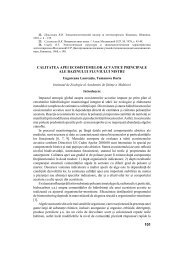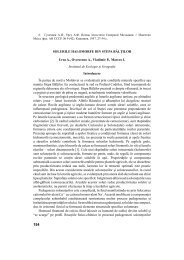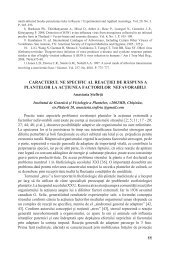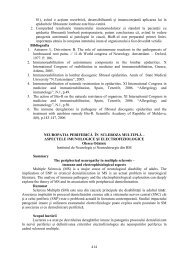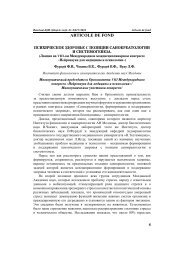209 CUPRINS
209 CUPRINS
209 CUPRINS
You also want an ePaper? Increase the reach of your titles
YUMPU automatically turns print PDFs into web optimized ePapers that Google loves.
The paper provides an analysis of the impact of the introduction of scienti c achievements<br />
in vegetable growing. The complexity and diversity of the situation in agricultural production<br />
shows that the development of technologies of vegetable crop cultivation should be conducted<br />
in the direction of greater differentiation followed by adaptation to the speci c conditions of<br />
each eld. Nonstandard issues in the whole industrial situation complicate the decision making<br />
process without additional information that can be found in the operational mode only in the<br />
presence of process control systems and the development of technological solutions based on a<br />
comprehensive analysis of the knowledge and data collected and systematized scienti cally.<br />
10 references<br />
UDC: 581.1.03:581.14<br />
THE CONTRIBUTUION OF PEROXIDASE ENZYMES IN THE<br />
ANTIOXIDATIVE PROTECTION OF PLANTS IN DROUGHT CONDITIONS.<br />
Ştefîrţă Anastasia,, Aluchi N., Melenciuc M., Buceaceaia Svetlana. //Buletinul Academiei de<br />
Ştiinţe a Moldovei. Ştiinţele Vieţii. 2011, No 1 (313), p. 51-62.<br />
The premises of the peroxidase enzyme involvement in the induction of antioxidative<br />
protective mechanisms in the leaves of Zea mays plants with different resistance potential have<br />
been studied. Tissue dehydration, caused by water scarcity, has been demonstrated to induce<br />
changes in the balance of the antioxidant enzyme activity disturbing the activity rate between<br />
SOD and CAT, SOD and PX. The SOD, CAT, and APX activity rate decreases, while the phenol,<br />
guaiacol and glutathione speci c peroxidase activity increases. Drought intensi cation in time<br />
results in a signi cant reduction of the magnitude and speed of protective antioxidative enzyme<br />
activation. Drought tolerant plants, due to their water homeostatic capacity to maintain tissue<br />
hydration, are less affected by ROS and, consequently, the degree of the enzyme peroxidase<br />
activation is lower.<br />
24 references, 1 table, 5 gures<br />
UDC: 633.8:631.527<br />
QUANTITATIVE CHARACTERS, CONTENT, AND CHEMICAL<br />
COMPOSITION OF THE ESSENTIAL OIL OF NEW OCIMUM BASILICUM<br />
L. GENOTYPES. Gonceariuc Maria, Balmuş Zinaida, Gille Elvira, Spac A., Ganea<br />
A., Botnarenco P. //Buletinul Academiei de Ştiinţe a Moldovei. Ştiinţele Vieţii. 2011,<br />
No 1 (313), p. 62-72.<br />
Quantitative characters, content and chemical composition of essential oil have been studied<br />
in eight Ocimum basilicum genotypes of hybrid origin that differ in the color of leaves and<br />
owers. The values of the quantitative characters vary considerably depending on the genotype<br />
and growing conditions, but no correlation has been established between the characters and the<br />
color of leaves and owers. The content of essential oil ranges between 0.403% and 1.405%<br />
(dry matter). The value of essential oil content is high (1.168-1.405%) in most genotypes<br />
with red owers. Gas-chromatographic analysis showed considerable differences in chemical<br />
composition of essential oil, concentration of each component in relation to the genotype.<br />
The number of the components identi ed ranges from 30 to 52 and does not correlate with<br />
the quantitative characters and the color of leaves and owers. The concentration of the main<br />
components in the essential oil varies as follows: citral is the major component (47.16-62.29%)<br />
in two genotypes; linalool is the major component (36.93-50.85%) in six genotypes. The<br />
second signi cant for the concentration component is linalool (10.85%) in one genotype, citral<br />
(12.59%) in another genotype, and methylchavicol (9.97-24.34%) in the other three genotypes.<br />
The Ocimum basilicum genotypes under study can be divided into ve chemotypes for the<br />
major components in the essential oil: 1-citral/linalool; 2-citral; 3-linalool; 4-linalool/citral;<br />
5-linalool/methylchavicol genotypes.<br />
24 references, 4 tables, 8 gures.<br />
196


